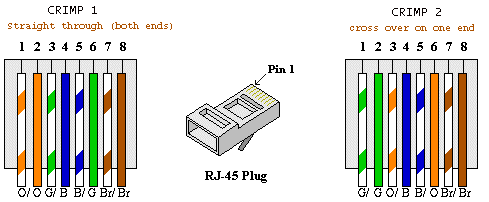 +
+  ( RJ45 crimper and a few 'icecubes')
( RJ45 crimper and a few 'icecubes') | MonkeyBrains.net/~rudy/example | Random examples |
I've crimped a lot of ethernet wires. Here is my personal refernece page.
 +
+  ( RJ45 crimper and a few 'icecubes')
( RJ45 crimper and a few 'icecubes')
RJ-45 crimping: Ethernet!

|
|---|
10BaseT Ethernet: The most popular method of connecting computers to each other in the home and office. Data travels at 10 Mega-bits per second (and there are 8 bits per byte, so 10Mb = 1.25 Mega Bytes/s). The RJ-45 Plug at each end is like a phone jack, but wider. The wire used is (generally) Cat-3 or Cat-5. If you are running a 10BaseT network, Cat-3 wire is cheaper and works fine. If you have 100BaseT ethernet cards installed, Cat-5 wire is better. These wires have pairs of wires twisted together to reduce inductance, resistance, etc. Straight-through: CRIMP 1 on both ends. Used to hook computers to Hubs. Cross-Over: CRIMP 1 on one end and CRIMP 2 on the other. Used to hook one hub into another hub. Also used to directly connect two computers. Tool: You need a crimping tool which is made for crimping RJ-45 jacks. Usually, you can find one that can does RJ-11 and RJ-22 as well. RJ-11 is the jack size for your telephone. RJ-22 is the phone to headset wire. RJ-45 = 8 wires (10 wide, only 8 used) RJ-11 = 6 wire jack (with only 4 used) RJ-22 = 4 wire jack Cat3 is okay for 10BaseT adequate for networks with up to several dozen computers sharing a DSL line This wire is cheaper that cat5 wire Distance Tip: If you need to run a real long ethernet cable, use Cat-5 and run your ethernet cards at 10Mbps instead of 100Mbps. The slower speed allows the signal to work over longer cables. |
| Need to host a domain? Check out my kickass ISP: MonkeyBrains.Net |
|
Here is an excerpt from csp.com:
CAT5:
CAT5e:
CAT6: |